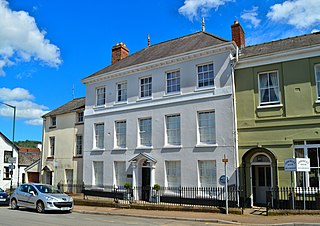
The Dispensary is a Georgian town house which is fairly typical of many town-centre houses in Monmouth, Wales, dating from the mid 18th century, but with early 19th-century additions. It stands in St James Square, opposite the Catalpa tree. The building was listed at Grade II on 27 June 1952.

St Mary's Roman Catholic Church, in St Mary's Street near the centre of Monmouth, is the earliest post-Reformation Catholic public place of worship to be permitted in Wales. The church is a late Georgian Roman Catholic church with later Victorian additions by the Catholic convert architect Benjamin Bucknall. It has been designated as a Grade II listed building since 15 August 1974, and is one of 24 buildings on the Monmouth Heritage Trail.

The County Gaol, situated in North Parade, Monmouth, Wales, was Monmouthshire's main prison when it was opened in 1790. It served as the county jail of Monmouthshire and criminals or those who fell foul of the authorities were hanged here until the 1850s and some 3,000 people viewed the last hanging. The jail covered an area of about an acre, with a chapel, infirmary, living quarters and a treadmill. It was closed in 1869. In 1884 most of the building was demolished, and today nothing remains but the gatehouse which is a Grade II listed building. Within the gatehouse, there exists "a representation in coloured glass of the complete original buildings". It is one of 24 buildings on the Monmouth Heritage Trail.

Hyam's Mineral Water Works is a nineteenth century building at 23 Glendower Street, Monmouth, Wales. Formerly a mineral water works, it is currently used as residential apartments. The building holds one of the 24 blue plaques awarded by the Monmouth Civic Society to buildings of especial historical and social interest, and features on the Monmouth Heritage Trail.
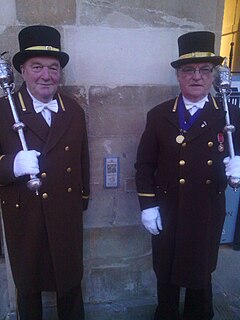
The Mayor of Monmouth is an elected position given to a town councillor in Monmouth in Wales. The position dates back about 750 years.
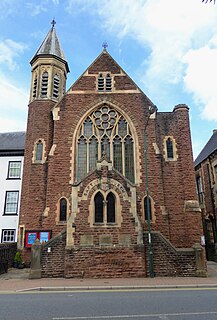
Monmouth Baptist Church is located in Monk Street, Monmouth, south east Wales. The church building was opened in 1907, although the Baptist congregation had been formed in 1818. The church became a Grade II listed building on 27 October 1998.
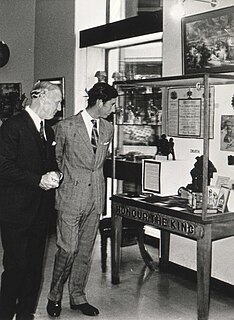
Keith Edward Kissack MBE was a British schoolteacher and historian. He is notable for his many publications on the history of Monmouth and Monmouthshire.

Church Street is a pedestrianised street in the centre of Monmouth, Wales. It contains a variety of independent shops, restaurants, commercial art galleries, and the Savoy Theatre. Until the 1830s, when Priory Street was built to bypass it, it was the main thoroughfare into the centre of Monmouth from the north-east, linking the market and the parish church. It was at one time the centre of the town's butchery trade and was known as Butcher's Row.

Overmonnow is that part of the town of Monmouth, in Wales, which is located to the west of the River Monnow and the Monnow Bridge. It developed as a suburb of the town in the Middle Ages, when it was protected by a defensive ditch, the Clawdd-du or "Black Dyke", the remains of which are now protected as an ancient monument. In later centuries the area became known as "Little Monmouth" or "Cappers' Town". Development of the area has continued, particularly since the mid-twentieth century, and the area is now a ward of Monmouthshire County Council.

Vauxhall Fields, also known as Vauxhall Meadows, are water meadows to the northwest of Monmouth town centre, Wales. The River Monnow borders the meadows on two sides. The meadows have generally remained free of development. The area has been prone to flooding on many occasions over the years.
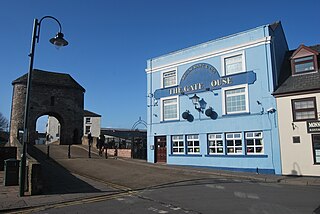
The Gatehouse, also known as The Gate House, is a public house located next to Monnow Bridge in Monmouth, Wales. The pub was known as the Barley Mow until it changed its name in 1993. It is the only public house in Monmouth located beside a river. The pub has a restaurant area, seated balcony and a function room.

The Queens Head is a public house located at 1, St James Street, Monmouth, Wales. It has also known as The Queens Head Hotel and formerly Queens Head Inn.
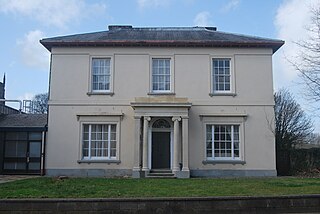
Oak House is a Grade II Listed building in Monk Street Monmouth, Wales.

1 Monk Street, Monmouth was built as a Working Men's Free Institute. It is a Grade II Listed building in Monmouth, Wales and located next to Monmouth Baptist Church.

North Parade House, in Monmouth Wales, dates from the late 18th century, and was refurbished in c.1800 by a wool merchant who took over the malthouse next door as a wool store, along with the cottages further up the street as housing for his workers. It has been a grade II listed building since 27 October 1965.
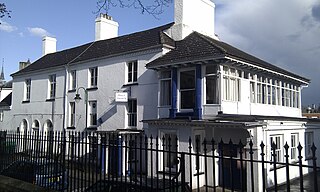
Priory House is a Grade II Listed building in Monmouth, Wales.
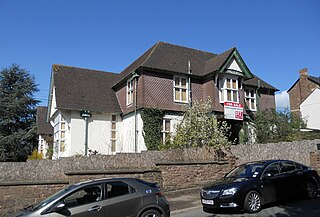
The Cottage Hospital was a community hospital on the Hereford Road in Monmouth, Wales.

1–6 Priory Street in Monmouth, Wales, is a row of six shop houses designed by the architect George Vaughan Maddox and constructed c. 1837. They form part of Maddox's redevelopment of the centre of Monmouth and stand opposite his Market Hall. The architectural historian John Newman has written that Maddox's work "gives Monmouth its particular architectural flavour," and considers Priory Street to be "his greatest work."

12–16 Church Street in Monmouth, Wales, is a row of three shop houses designed by the architect George Vaughan Maddox and constructed c. 1837. They form part of Maddox's redevelopment of the centre of Monmouth and stand on Church Street, to the rear of Maddox's Priory Street. The architectural historian John Newman has written that Maddox's work "gives Monmouth its particular architectural flavour" and Cadw describes the grouping of 12–16 Church Street as "the best preserved early 19th century shopfront in Monmouth."
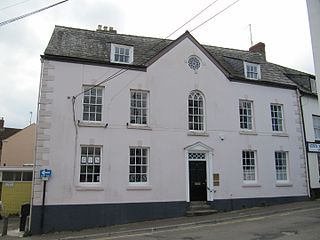
9 Agincourt Street, Monmouth, Wales is a late 17th century townhouse which became the estate office of the agent of the Dukes of Beaufort in the mid 19th century. It is a Grade II* listed building. In commercial use since its construction, it now houses a firm of architects.





















